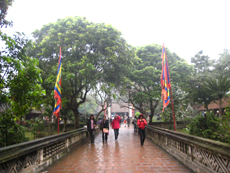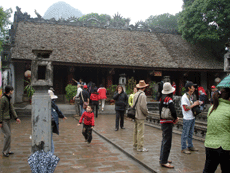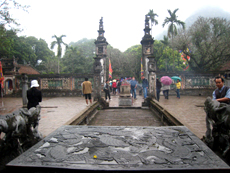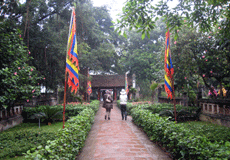On a spring morning, we visit the ancient Hoa Lu capital, now in Truong Yen Commune, Hoa Lu District, in the northern province of Ninh Binh.
|
 |
|
Just the beginning: The entrance to the
Temple for King Dinh Tien Hoang. |
Hoa Lu means "Flowers of Reeds" and was the capital city of the Dinh dynasty (968-980) and the Tien Le (Early-Le) dynasty (980-1009). The Ly dynasty (1010-1225) was also formed from this capital city.
Arriving at the ancient capital, tourists always visit the temple of King Dinh Tien Hoang (Dinh Bo Linh), who built up Hoa Lu as the capital and set up the first centralised feudal State in Viet Nam, as well as the temple of the first king of the Tien Le dynasty, King Le Dai Hanh (Le Hoan).
Hoa Lu as a capital city existed for only 41 years, from 968 to 1009, during which time the first 12 years belonged to the Dinh Dynasty. Dinh Bo Linh was crowned as King Dinh Tien Hoang and he named the country Dai Co Viet. The next 29 years were ruled by the Tien Le Dynasty.
Though the time is very short compared to the nation’s thousand-year history, the ancient capital of Hoa Lu marks a splendid historical time in the country. During the time of the Dinh and Le dynasties, feudal Viet Nam was powerful, and the Vietnamese people completely defeated an invasion by China’s Song Dynasty.
|

|
|
The complex of two temples for King Dinh
and King Le attract lots of visitors. |
According to historians, archaeological excavations prove that 1,000 years ago, Hoa Lu was a magnificent royal citadel. The Hoa Lu Citadel covers 300ha, consisting of an outer and inner zone, linked together by a narrow road. Endless mountains and the Hoang Long River around the capital city defend it against military attacks.
But in 1,010, as the country stepped into a higher development stage, King Ly Thai To decided to move the capital city to Thang Long (now Ha Noi), where it remains to this day. Since then, Hoa Lu has been known as the former capital.
Today, on the foundation of the ancient royal palaces, sit the two temples, 500m from each other.
The temple of King Dinh Tien Hoang is located among ancient trees, orchards and ornamental trees, all intermingling to create a solemn scene. Entering the temple, we are attracted by unique wood and stone carvings by Vietnamese artisans in the 17th-19th centuries.
In front of the temple lies a large stone bed. Its face has a carved image of a dragon, with a foot holding its beard.
|
 |
|
Stone bed in the dragon yard |
Walking on the main path, passing two big columns, visitors enter san rong (dragon yard). Perhaps, it used to be the place where the king gave audience to his mandarins. In the middle of the dragon yard is a stone bed, 1.8m long and 1.4m wide. On the two sides of the bed are two unicorns, made of two entire green rocks.
In the middle of the main sanctum, the bronze statue of King Dinh Tien Hoang sits on a green-stone platform.
On his left and right sides are two stone dragons. The right chamber is to worship the King’s two sons: Dinh Toan and Dinh Hang Lang. The left chamber worships the King’s first son, Dinh Lien.
The temple is surrounded by a "natural wall", with a semi-circle lotus pond on the east side and a single mountain to the west. The surrounding mountains create a maze of valleys and caves, which were used to store food for soldiers and horses during the feudal period.
From King Dinh Temple, we walk 500m to visit the temple for King Le Dai Hanh and Queen Duong Van Nga. She used to be the wife of Dinh Bo Linh, but after he died, she had to cede the throne to Le Hoan (King Le Dai Hanh) to fortify the country to cope with an invasion by the northern Song Dynasty.
This temple is reflected in a branch of the Hoang Long River, and it is smaller than the King Dinh Temple.
Walking along the road to the temple, on the left-hand side, there is a large rock, 3m high, with an image of a dancing phoenix with its wings spread. On the right-hand side we see a rookery, with an image of a reclined tiger, close to an old tree, over 300 years old.
|
 |
|
The entrance to the Temple for King Le Dai Hanh |
Visitors pass rocks with images of a kneeing elephant, a phoenix incubating its eggs and a long ma (a half-dragon, half-horse creature).
The statue of King Le Dai Hanh sits in the middle of the main sanctum. On the left sits the statue of King Le Long Dinh (the fifth son of King Le Dai Hanh), and on the right sits the statue of Queen Duong Van Nga.
Like the decorations in King Dinh Temple, the temple of King Le features wooden sculpture art of the 17th century, of a very polished and refined standard.
In the large lawn in the middle of the two temples, local people form a small market that sells local products, mostly ornamental trees and rocks with artistic works upon them.
Nguyen Thi Lien, a local seller, says her father and husband make the rocks and shape ornamental trees for her to sell at the market.
"We sell these products to tourists; each rock is sold for between VND60,000-100,000 (US$5.7), while an ornamental tree is cheaper, from VND10,000-50,000," she says. "Serving tourists brings us a little extra income, in addition to our farms."
Not far from the two temples is the Nhat Tru (One-Pillar) Pagoda, which has a stone pillar carved with Buddhist scriptures, and a memorial stele house for King Ly Thai To, inaugurated on September 29, 2000, on the celebration of the 990th anniversary of Hoa Lu - Thang Long - Ha Noi.
Tourists should understand the historical significance of the ancient capital, says visitor Truong Thi Diem, a Hanoian teacher.
"The two temples and the stele house for King Ly let future generations know that this region used to be the magnificent royal citadel of two dynasties, Dinh and Le, and the birth place of the Ly Dynasty, before King Ly Thai To moved the country’s centre to Thang Long - Ha Noi," she says.